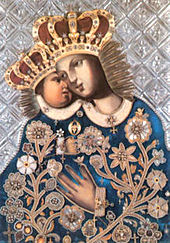Kalwaria Zebrzydowska Park
| Kalwaria Zebrzydowska Park | |
|---|---|
|
UNESCO world heritage |
|

|
|
| Basilica and monastery complex |
|
| National territory: |
|
| Type: | Culture |
| Criteria : | (ii, iv) |
| Reference No .: | 905 |
| UNESCO region : | Europe and North America |
| History of enrollment | |
| Enrollment: | 1999 (session 23) |
The Kalwaria-Zebrzydowska-Park (Sanktuarium Pasyjno-Maryjne Kalwaria Zebrzydowska) in the southern Polish town of Kalwaria Zebrzydowska ( German Kalwarya ) is a Calvary in Lesser Poland and an ensemble of Mannerist buildings, a landscape park and pilgrimage site . Since 1999, it is UNESCO - World Heritage Site . It is still a place of pilgrimage today.
history
Kalwaria Zebrzydowska owes its establishment to the Krakow voivode Mikołaj Zebrzydowski . In 1601 he had a small chapel of the Holy Cross built on Mount Żarek based on the model of the Golgotha chapel in Jerusalem. He believed to see a resemblance to Jerusalem in the area. The Bernardine monastery and a church were built by 1609 . Other Jerusalem-inspired chapels were built later. One of the mountains was renamed Golgotha, another the Mount of Olives, and the river the Cedron Brook . The neighboring town Zebrzydowa received the 1617 city law . Zebrzydowski's son and grandson extended the monastery complexes until 1655 and added more chapels to them.
The Calvary came to the Czartoryski family through the marriage of the great-granddaughter . Magdalena Czartoryska and her son Józef gave the ensemble its present form.
With the first partition of Poland in 1772, the place became part of Austria and was named Kalwarya , since 1912 it has been called Kalwaria Zebrzydowska. Building sins of the 19th century were corrected around 1900, later expansion plans were rejected.
The image of Mary from Kalwaria
In 1641 an oil painting of a Mother of God from the 17th century was donated to the monastery, according to tradition the picture is said to have cried beforehand. The miracle was recognized as such by the church in 1656 and a special chapel was built for St. Mary of Kalwaria (Matka Boska kalwaryjska), which became the destination of many pilgrimages.
UNESCO world heritage
In 1999 the pilgrimage site became a UNESCO World Heritage Site and 2000 a monument to the history of the Polish nation . UNESCO describes Kalwaria Zebrzydowska as "a breathtaking cultural landscape of great spiritual importance". The complex is an extraordinary cultural monument, in which chapels are embedded in the natural landscape as a backdrop as a symbolic representation of the Passion of Christ. The cultural landscape and architecture are connected in a harmonious way. Kalwaria Zebrzydowska is an example of the heyday of the construction of calvaries during the Counter Reformation in the late 16th century. The place is "an outstanding example of this type of large-scale landscaping". The facility has an area of 380 hectares and a buffer zone of 2600 hectares.
Plant and use
- Basilica of St. Maria, designed by Giovanni Maria Bernardoni , built by Paul Baudarth, architect from Antwerp, 1603–1609. Extended in 1702, church towers from 1720.
- Ecce Homo Chapel , designed by Giovanni Maria Bernardoni , built by Paul Baudarth, 1605–1609. The building has the plan of a Greek cross and is decorated in the style of Dutch Mannerism.
- Holy Cross Chapel, the first building on the complex, built between 1600 and 1601.
- Herz-Mariä-Kapelle , designed by Paul Baudarth, 1615. The building has the plan of a heart.
- Other chapels and buildings from the 17th and 18th centuries.
During Holy Week, the great Passion Play with hundreds of thousands of people takes place here. Over a million pilgrims come to the facility every year. The 40 pilgrimage destinations are picturesquely scattered on the surrounding hills and in the Cedron Valley.
Others
The facility was the model for St. Annaberg in Silesia, which was on the list of nominations for the Polish World Heritage Site in the 1990s. The pilgrimage site was founded in 1979 and 2002 by Pope John Paul II and in 2006 by his successor Benedict XVI. visited.
literature
- Augustyn Chadam: Śpiewnik Kalwaryjski Kalwaria Zebrzydowska 1997.
Web links
- Official website of the World Heritage Kalwaria Zebrzydowska (German)
- UNESCO.org: Kalwaria Zebrzydowska: the Mannerist Architectural and Park Landscape Complex and Pilgrimage Park. (Official List of World Heritage Sites; Eng.)
- Official website of the municipality (Polish)
Individual evidence
- ↑ Barbara Swiech: Kalwaria Zebrzydowska Sanctuary (engl.)
- ↑ Criterion ii of the World Heritage Commission
- ^ Criterion iv of the World Heritage Commission
Coordinates: 49 ° 51 ′ 37.1 ″ N , 19 ° 40 ′ 14.6 ″ E






